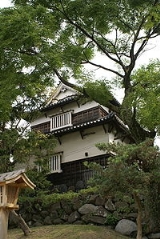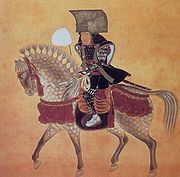
Kuroda clan
Encyclopedia
The was a Japanese samurai clan which came to prominence during the Sengoku period
.
.
. Under the heaship of Kuroda Yoshitaka, the clan served the Oda and later Toyotomi clans. Yoshitaka specifically worked as a battle tactician
, and was considered to be on par with Takenaka Shigeharu
, another prominent tactician of the era. For his service, Yoshitaka received lordship of Nakatsu Castle, in 1587. Yoshitaka was also a Roman Catholic with the baptismal name of "Don Simeon."
 At the Battle of Sekigahara
At the Battle of Sekigahara
in 1600, Tokugawa Ieyasu's Eastern Army defeated Ishida Mitsunari
's Western Army, and Ieyasu emerged as the dominant power figure in Japan. Kuroda Yoshitaka and his son Nagamasa
supported Ieyasu in combat, and for their service, were rewarded with a transfer to the Fukuoka Domain
, rated at 520,000 koku
of land.
Two branches of the family were founded in 1623. Kuroda Nagamasa's 3rd son Nagaoki founded the first; he was given 50,000 koku
of land which became the Akizuki Domain. Nagamasa's fourth son Takamasa founded the second; he was given 40,000 koku
of land which became the Tōren-ji Domain.
The forces of the Kuroda clan of Fukuoka took part in the Shimabara Rebellion
in 1638. 18,000 men under Kuroda Tadayuki assisted in laying siege to Hara Castle
.
In 1784, two schools were founded for the Fukuoka domain's samurai sons, Shūyū-kan and Kantō-kan. Of the two, Shūyū-kan still exists as Shūyū-kan Prefectural High School.
and the Battle of Hakodate
, among others.
Akizuki
Tōren-ji
(as Naogata domain)
Sengoku period
The or Warring States period in Japanese history was a time of social upheaval, political intrigue, and nearly constant military conflict that lasted roughly from the middle of the 15th century to the beginning of the 17th century. The name "Sengoku" was adopted by Japanese historians in reference...
.
Origins
The Kuroda clan claimed its origins in Tōtōmi ProvinceTotomi Province
was a province of Japan in the area of Japan that is today western Shizuoka Prefecture. Tōtōmi bordered on Mikawa, Suruga and Shinano Provinces. Its abbreviated form name was .-History:...
.
Sengoku era
In the 16th century, the Kuroda clan was located in Harima ProvinceHarima Province
or Banshu was a province of Japan in the part of Honshū that is the southwestern part of present-day Hyōgo Prefecture. Harima bordered on Tajima, Tamba, Settsu, Bizen, and Mimasaka Provinces. Its capital was Himeji....
. Under the heaship of Kuroda Yoshitaka, the clan served the Oda and later Toyotomi clans. Yoshitaka specifically worked as a battle tactician
Military tactics
Military tactics, the science and art of organizing an army or an air force, are the techniques for using weapons or military units in combination for engaging and defeating an enemy in battle. Changes in philosophy and technology over time have been reflected in changes to military tactics. In...
, and was considered to be on par with Takenaka Shigeharu
Takenaka Shigeharu
, who was also known as Hanbei , was a Japanese samurai during the Sengoku period of the 16th century. He initially served the Saitō clan of Mino province, but later plotted an uprising and took over the Saitō clan's castle at Mount Inaba. Toyotomi Hideyoshi was so impressed by this tactic that he...
, another prominent tactician of the era. For his service, Yoshitaka received lordship of Nakatsu Castle, in 1587. Yoshitaka was also a Roman Catholic with the baptismal name of "Don Simeon."
Edo era

Battle of Sekigahara
The , popularly known as the , was a decisive battle on October 21, 1600 which cleared the path to the Shogunate for Tokugawa Ieyasu...
in 1600, Tokugawa Ieyasu's Eastern Army defeated Ishida Mitsunari
Ishida Mitsunari
Ishida Mitsunari was a samurai who led the Western army in the Battle of Sekigahara following the Azuchi-Momoyama period of the 17th century. Also known by his court title, Jibunoshō...
's Western Army, and Ieyasu emerged as the dominant power figure in Japan. Kuroda Yoshitaka and his son Nagamasa
Kuroda Nagamasa
was a daimyo of Japan. He was the son of Kuroda Kanbei.In 1577, When Nagamasa was a small child, his father was condemned as a spy by Oda Nobunaga. Nagamasa was kidnapped and nearly killed as a hostage. Takenaka Hanbei ended up rescuing him....
supported Ieyasu in combat, and for their service, were rewarded with a transfer to the Fukuoka Domain
Fukuoka Domain
The ' was a Japanese domain of the Edo period, located in Chikuzen Province .-List of lords:*Kuroda clan, 1600-1871 #Nagamasa#Tadayuki#Mitsuyuki#Tsunamasa#Nobumasa...
, rated at 520,000 koku
Koku
The is a Japanese unit of volume, equal to ten cubic shaku. In this definition, 3.5937 koku equal one cubic metre, i.e. 1 koku is approximately 278.3 litres. The koku was originally defined as a quantity of rice, historically defined as enough rice to feed one person for one year...
of land.
Two branches of the family were founded in 1623. Kuroda Nagamasa's 3rd son Nagaoki founded the first; he was given 50,000 koku
Koku
The is a Japanese unit of volume, equal to ten cubic shaku. In this definition, 3.5937 koku equal one cubic metre, i.e. 1 koku is approximately 278.3 litres. The koku was originally defined as a quantity of rice, historically defined as enough rice to feed one person for one year...
of land which became the Akizuki Domain. Nagamasa's fourth son Takamasa founded the second; he was given 40,000 koku
Koku
The is a Japanese unit of volume, equal to ten cubic shaku. In this definition, 3.5937 koku equal one cubic metre, i.e. 1 koku is approximately 278.3 litres. The koku was originally defined as a quantity of rice, historically defined as enough rice to feed one person for one year...
of land which became the Tōren-ji Domain.
The forces of the Kuroda clan of Fukuoka took part in the Shimabara Rebellion
Shimabara Rebellion
The was an uprising largely involving Japanese peasants, most of them Catholic Christians, in 1637–1638 during the Edo period.It was one of only a handful of instances of serious unrest during the relatively peaceful period of the Tokugawa shogunate's rule...
in 1638. 18,000 men under Kuroda Tadayuki assisted in laying siege to Hara Castle
Hara Castle
is a castle in Hizen Province. During the Shimabara Rebellion , the rebellious peasants were besieged there.As a result of the Shimabara Rebellion in 1637, the Shogunate decided to expel the Portuguese from Japan...
.
In 1784, two schools were founded for the Fukuoka domain's samurai sons, Shūyū-kan and Kantō-kan. Of the two, Shūyū-kan still exists as Shūyū-kan Prefectural High School.
Boshin war
During the Boshin War of 1868-69, the Kuroda clan supported the imperial government. Troops from Fukuoka took part in the Battle of AizuBattle of Aizu
The Battle of Aizu was fought in northern Japan in autumn 1868, and was part of the Boshin War.Aizu was known for its martial skill, and maintained at any given time, a standing army of over 5000. It was often deployed to security operations on the northern fringes of the country, as far north as...
and the Battle of Hakodate
Battle of Hakodate
The was fought in Japan from October 20, 1868 to May 17, 1869, between the remnants of the Tokugawa shogunate army, consolidated into the armed forces of the rebel Ezo Republic, and the armies of the newly formed Imperial government...
, among others.
Key Genealogies
Fukuoka- Kuroda Takamasa (?-1523?)
- Kuroda Shigetaka (1508-1564)
- Kuroda Mototaka (1522-1585)
- Kuroda Yoshitaka (1546-1608)
- Kuroda NagamasaKuroda Nagamasawas a daimyo of Japan. He was the son of Kuroda Kanbei.In 1577, When Nagamasa was a small child, his father was condemned as a spy by Oda Nobunaga. Nagamasa was kidnapped and nearly killed as a hostage. Takenaka Hanbei ended up rescuing him....
(1568-1623)
- Kuroda Tadayuki (1602-1654)
- Kuroda Mitsuyuki (1628-1707)
- Kuroda Tsunamasa (1659-1711)
- Kuroda Nobumasa (1685-1744)
- Kuroda Tsugutaka (1703-1775)
- Kuroda Haruyuki (1753-1781)
- Kuroda Harutaka (1754-1782)
- Kuroda Naritaka (1777-1795)
- Kuroda Narikiyo (1795-1851)
- Kuroda NagahiroKuroda NagahiroMarquess was a Japanese daimyo of the late Edo period, who ruled the Fukuoka Domain.-Biography:Nagahiro was the ninth son of Shimazu Shigehide, lord of Satsuma Domain; Kuroda Narikiyo, lord of Fukuoka, adopted Nagahiro in 1822...
(1811-1887)
- Kuroda NagatomoKuroda Nagatomowas a Japanese samurai of the late Edo period, who served as the last daimyō of Fukuoka han. He was adopted into the family and was born the second son of Tōdō Takayuki, lord of the Tsu han. A pro-Chōshū figure during the tumultuous Bakumatsu era, he allied with the new government in the Boshin War...
(1839-1902) - Kuroda Nagashige (1867-1939)
- Nagamichi Kuroda (1889-1978)
- Nagahisa Kuroda (1916-)
Akizuki
- Kuroda Nagaoki (1610-1665)
- Kuroda Nagashige
- Kuroda Naganori
- Kuroda Nagasada
- Kuroda Nagakuni
- Kuroda Nagayoshi
- Kuroda Nagakata
- Kuroda Naganobu
- Kuroda Nagatsugu
- Kuroda Nagamoto
- Kuroda Nagayoshi
- Kuroda Naganori
Tōren-ji
- Kuroda Takamasa (1612-1639)
- Kuroda Yukikatsu (1634-1663)
- Kuroda Nagahiro (1659-1711)
(as Naogata domain)
- Kuroda Nagakiyo (1667-1720)
Japanese
On Kuroda Yoshitaka- Andō Hideo 安藤英男. Shiden Kuroda Josui 史伝黒田如水. Tokyo: Nichibō Shuppansha, 1975.
- Harada Tanemasa 原田種眞. Kuroda Josui 黒田如水. Tokyo: Benseisha 勉誠社, 1996.
- Kaneko Kentarō 金子堅太郎. Kuroda Josui den 黒田如水伝. Tokyo: Bunken Shuppan 文献出版, 1976.
- Motoyama Kazuki 本山一城. Jitsuroku Takenaka Hanbei to Kuroda Kanbei 実錄竹中半兵衛と黒田官兵衛. Tokyo: Murata Shoten 村田書店, 1988.
- Yoshikawa, Eiji. (1989) Yoshikawa Eiji Rekishi Jidai Bunko (Eiji Yoshikawa's Historical Fiction), Vol. 44: Kuroda Yoshitaka (黒田如水). Tokyo: Kodansha. 10-ISBN 4-0619-6577-8; 13-ISBN 978-4-0619-6577-5

